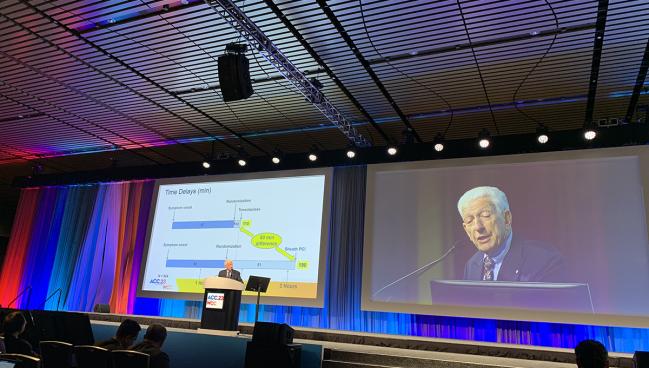STREAM-2: Half-Dose Tenecteplase Safe, Effective in Older STEMI Patients
When timely PCI is unavailable, a half-dose option can reduce—but not eliminate—intracranial hemorrhage risk in this group.

NEW ORLEANS, LA—When timely primary PCI is not possible, a pharmacoinvasive strategy of half-dose tenecteplase may provide a safe and effective reperfusion alternative in older patients with STEMI, according to an analysis from the STREAM-2 trial.
The findings add context to the prior STREAM-1 trial, in which a pharmacoinvasive strategy was at least as effective as primary PCI in patients with early STEMI presentation, although it was associated with much higher rates of intracranial hemorrhage (ICH). STREAM-1 adopted the half-dose tenecteplase approach in the 75-and-older age group during the trial and saw a sharp drop in ICH, which prompted a mandate in the STREAM-2 study for the half-dose protocol to be used in the entire cohort, which consisted of patients aged 60 and older.
Presenting here at the American College of Cardiology/World Congress of Cardiology (ACC/WCC) 2023 meeting, Paul Armstrong, MD (University of Alberta, Edmonton, Canada), showed that at 30 days, the composite clinical endpoint of death, heart failure, shock, and reinfarction was comparable between patients randomized in an ambulance or community hospital to half-dose tenecteplase and those who underwent primary PCI (12.8% vs 13.3%; RR 0.96; 95% CI 0.62-1.48).
Despite the lower dose, ICH occurred in six patients (1.5%) in the tenecteplase group and in none of the primary PCI patients, but according to Armstrong, a closer look found that three of the six cases had protocol violations: excessive anticoagulation in two patients and BP that exceeded the exclusion criteria in another.
“The rate of intracranial hemorrhage was higher than anticipated, at least in part based on those three cases, we think, attributable to protocol violations,” Armstrong said. “So, provided contraindications to lysis are observed, and excess anticoagulation avoided, a pharmacoinvasive strategy as used in this trial is effective and we think can be safely given to older STEMI patients if timely PCI is unavailable, which is often the case, especially in patients that are presenting to community hospitals.”
In STREAM-1, patients aged 75 and older got the half-dose tenecteplase along with 150 to 325 mg aspirin before transport to a PCI-capable hospital. Younger patients received a low-molecular-weight enoxaparin bolus of 30 mg followed by subcutaneous injection of 1.0 mg/kg every 12 hours, while the older patients only received subcutaneous injection of 0.75 mg/kg every 12 hours (without a bolus); both age groups also received a loading dose of clopidogrel 300 mg. For STREAM-2 the protocol included 300 mg of clopidogrel regardless of age in addition to the half-dose tenecteplase, while still omitting the initial enoxaparin bolus in those age 75 and older.
Panelist Cindy Grines, MD (Northside Hospital Cardiovascular Institute, Atlanta, GA), asked Armstrong if he was suggesting that physicians alter “who we give thrombolytics to altogether” based on age.
“No, I'm not, but I am suggesting that possibly our original thinking around the dosing of fibrinolytic based on angiographic criteria may be incorrect,” Armstrong responded. “Especially when you couple that with a pharmacoinvasive strategy, I think that you get a fair amount of bang for the buck on efficacy and you get a margin of safety as well.”
Armstrong added that, as a result of STREAM-2, the manufacturer Boehringer Ingelheim “is now prepared to produce half-dose vials of tenecteplase.”
Efficacy and Safety Results
STREAM-2 enrolled 600 patients (mean age 71 years; 32% female) who presented within 3 hours of STEMI symptom onset, had 2 mm or greater ST elevation in two or more contiguous leads, and could not undergo primary PCI within 1 hour of first medical contact. More than 90% of patients were in Killip class I, mean systolic BP was 134 mm Hg, mean heart rate was 76 bpm, and more than half of all infarcts were inferior.
Prior to hospital transport, patients were randomly assigned to primary PCI or fibrinolytic therapy. Those in the fibrinolytic group (n = 400) received half-dose tenecteplase based on weight in kg, aspirin, clopidogrel, and enoxaparin. Those in the primary PCI group (n = 200) received aspirin, a P2Y12 antagonist, and anticoagulation according to local practice. At the hospital, patients in the lytic group received an ECG within 90 minutes after tenecteplase, or earlier if clinically indicated, and those in the intervention group received an ECG prior to PCI.
PCI was performed in the pharmacoinvasive group if there was a < 50% resolution of ST deviation, or if angiography performed after a greater than a 50% resolution of ST deviation indicated that it was necessary. All patients had an ECG after PCI or last angiography. At baseline, the sum ST deviation was 15 mm in each group.
After tenecteplase bolus, 53% of patients had ST-sum deviation resolution. By the last angiography in the tenecteplase group and after primary PCI in those who received it, ST-sum deviation resolution rates were 71% and 62%, respectively (P = 0.03). Rescue or urgent PCI was performed in one-third of the pharmacoinvasive group.
There were no differences in lytic versus primary PCI patients in symptom onset to start of reperfusion time or in final TIMI 3 flow after PCI or last angiography despite a higher baseline TIMI 0/1 flow prior to PCI in the intervention group.
Looking at secondary endpoints at 30 days, all-cause mortality rates were 9.3% in the pharmacoinvasive group versus 8.9% in the primary PCI group, while rates of CV death were 7.3% and 8.4%, respectively; rates of any stroke were 2.3% and 0.5%, respectively; and rates of major non-intracranial bleeding were 1.3% and 1.0%, respectively. None of the differences were statistically significant.
Half-Dose Strategy ‘Makes Sense’
Dharam J. Kumbhani , MD (UT Southwestern Medical Center, Dallas, TX), who was not involved in the study, told TCTMD that the STREAM-2 data “suggest that half-dose [tenecteplase] probably makes sense as the default option for most patients undergoing a pharmacoinvasive strategy.”
Three years ago, as the COVID-19 pandemic was in full swing in the United States and elsewhere, Kumbhani and colleagues argued that a fibrinolytic-based strategy for STEMI patients may be a “reasonable consideration” for fast reperfusion when resources are limited and/or access to the cath lab isn’t possible, even though it is decidedly a suboptimal therapy with potential for adverse events.
Grines voiced concern about the fact that all of the ICH cases that occurred with tenecteplase were in patients under age 75, ranging from age 61 to 74.
“I know you said that there are some protocol violations, but does that raise any concern? And if so, is it not necessarily the tenecteplase, [but] the other medications that were given?” she asked.
“On the one hand, where we can argue that perhaps clopidogrel enhanced the efficacy, could there have been a safety signal associated with that? If that was the case, I would have thought we would have seen it in the patients over the age of 75,” Armstrong responded. However, he added that it is also important to consider that “chronology and biology in relationship to age and risk are not necessarily linearly related.”
L.A. McKeown is a Senior Medical Journalist for TCTMD, the Section Editor of CV Team Forum, and Senior Medical…
Read Full BioSources
Armstrong P. Pharmaco-invasive reperfusion with half-dose tenecteplase or primary PCI in older patients with STEMI. Presented at: ACC/WCC 2023. March 5, 2023. New Orleans, LA.
Disclosures
- Boehringer Ingelheim provided financial support for the study.
- Armstrong reports consulting fees/honoraria from Bayer, Boehringer Ingelheim, CSL Limited, Eli Lilly, Merck, and Novo Nordisk.





Comments